




































































Volume 1, Issue 6
March 2025
STAFF
PUBLISHER/EDITOR
Amy Thurman amy@roanmountainmagazine.com
EDITORIAL ASSISTANT
Diana Tolley
EDITORIAL ASSISTANT
Susie Phillips
GUN TALK WITH JON Captain Jon Strydom
NEWS FROM THE ROAN Ranger Marcianne O'Day
THE LAST WORD & THE GRACE PLACE
Noah Blair
STAFF PHOTOGRAPHER
Faith Lynn
STAFF WRITER
Ericka Hughes
CONTRIBUTORS
Andrea Mathews
Laura Oakes
Marco Rodriguez
Rebekah Thompson Oleg Volk
Copyright © 2025
All content herein is copyright protected and may not be reproduced in whole or part without express written permission.
Roan Mountain Magazine is published monthly and can be found at multiple locations throughout the Roan Mountain area, free to readers. We are not currently offering print subscriptions, but please contact us if you are unable to find a copy. (423) 440-9012
Read the Digital Version at: www.RoanMountainMagazine.com
or whatever you’d like to share, please send to Amy: amy@roanmountainmagazine.com
www.roanmountainmagazine.com
14 Business Spotlight: Tire Express
Tire Express is growing and has more to offer local residents.
16 Growing up on Buck
Laura Oakes shares her childhood memories and how growing up on Buck Mountain shaped who she is today.

18 Barred Owls
Learn more about this beautiful species, to include Shiloh the owl ambassador, and how you can help.
Editor’s Letter
Gun Talk with Jon Taste of the Roan The Grace Place News from the Roan Kid's Page What's Going On ... The Last Word
THE COVER: A wild barred owl scoping out the terrain. See more about these beautiful birds of prey on page 18.
Photo by Park Ranger Marco Rodriguez Roan Mountain State Park
19 Angel to Animals
Meet wildlife rehabilitator Denise Shadduck, and a few of her current charges.

22 Musician Noah McKinney
Erick Hughes talked with Noah about his music and country legend influences.
24 A Vist with Aunt Betty
Andrea Mathews visited with her Aunt, Betty Hoilman, and shares her memories of growing up in Roan Mountain.
25 Eager for Spring
A short story about a young boy longing for spring, by Diana Tolley.








As I sit here to write this column, with the wind howling like a wild beast outside my windows, I think we can safely say that March has come “in like a lion.” And I’m sure I’m not alone in looking forward to the “out like a lamb” half of that adage!
But after living in South Georgia for 25 years, with only the turning of calendar pages to mark the passing of time, I’m truly enjoying the change of seasons here and take pleasure in finding the beauty in each.
My friends back in Georgia were certain I’d be miserable come winter and regret my decision, but that hasn’t been the case. There’s so much to enjoy in winter! As a woman over 50, I have a far deeper appreciation for cold weather than I did in my younger years. It’s fun to break out the sweaters and boots, to crawl under a pile of blankets at night, to cook tasty soups and stews, and to have a fire going on particularly cold winter nights.
The world outside my toasty warm house is also a source of joy. I love snow and eagerly check the forecast each day with hopes of more. And not just because it hides all the flood mud. There’s little more beautiful than seeing trees dressed in stunning white coats, and the contrast between an almost neon blue sky against stark white peaks. There’s also the fun of tossing snowballs for Remington to catch, and there’s the peace and unique quiet that comes with snow.
Summer brings joy from digging in the dirt to tend gardens, cooking on the grill, shorts and t-shirts allowing the sun to warm our skin, and a wealth of outdoor activities to choose from. I’m outside more than in during the summer months and love every minute of it.
Spring has always been my favorite season though, and even more so here. Watching the mountains turn from brown to blankets of green, the bright sparks of color and scent as flowering plants come into bloom, the return of warmth, watching seedlings push up into the light and planting tender young plants in rich soil. The world around us bursts into life again after lying dormant through the colder winter months, bringing with it hope and excitement for new beginnings.
I sometimes hear people grumbling about whatever season we’re in at the moment.
Fall is magnificent as well. The brilliant shades or red, yellow, and orange in every direction and we don’t have to drive elsewhere to see it. Cooler temperatures, perfect for sitting around a firepit with friends. The scents of harvested crops tinting the air and meals prepared with the bounty we grew ourselves.
“I hate winter!” “I can’t wait for this heat to end!” “I’m sick of this wind!” (I might be guilty of that one.) But the truth of the matter is that each season brings its own unique beauty and what we look for is what we’re apt to see. If we look for the beauty in each season, we’ll see it. If we look for the negatives, that’s certainly what we’ll see instead. As we welcome Spring back this month, I hope you’ll all look for, and appreciate, the beauty of this season!
See you 'round the Roan!
Amy Campbell Clark Editor amy@roanmountainmagazine.com







Because my gun shop is a manufacturing, machining and repair business, I get quite a few questions about my favorite firearm accessory: silencers. Or to use the proper industry term, suppressors. In the U.S., suppressor ownership is regulated under the National Firearms Act (NFA) of 1934, administered by the Bureau of Alcohol, Tobacco, Firearms and Explosives (BATF). Suppressors are classified as Title II devices, meaning they require federal registration, a $200 tax stamp, and a thorough background check. Currently, suppressors are legal for civilian ownership in Tennessee and 42 states, though additional local restrictions may apply, so prospective owners must research their jurisdiction’s laws.
The process to acquire a suppressor typically involves selecting a model, purchasing it through a licensed dealer (Class III FFL/SOT), submitting ATF Form 4 with fingerprints and photos, and waiting for approval, which can take 6-12 months. Recent advancements, such as the ATFs eForms system, have streamlined this process, sometimes reducing wait times. My preferred method, which I recommend to clients, is to visit a "Powered By Silencer Shop" kiosk or visit Silencershop.com. It takes 5 minutes and streamlines the entire process. Ownership has surged in recent years, with the American Suppressor Association reporting over 3 million registered suppressors in circulation by 2023, a number likely higher today due to growing acceptance and legislative efforts to deregulate them, like the Hearing Protection Act (still under consideration as of 2025).
A suppressor works by slowing and cooling the high-pressure gases that exit a firearm’s muzzle when a shot is fired. Contrary to Hollywood depictions, suppressors do not eliminate sound—they reduce it by 20-35 decibels (dB), depending on the firearm, ammunition, and suppressor design. For context, an unsuppressed gunshot can exceed 160 dB, well above the 140 dB threshold for hearing damage, while a suppressed shot might drop to 120-130 dB, still loud but safer for the shooter’s ears.
The basic design consists of a usually cylindrical metal tube housing a series of baffles or chambers. Most are designed to be disassembled for cleaning and some are sealed, welded units. I've also recently seen a 3-d printed baffle core. When a bullet is fired, the propellant gases expand rapidly behind the bullet, causing a shockwave which we hear as a loud bang. The suppressor traps these gases, allowing them to expand gradually within the chambers, dissipating
By Jon Strydom (aka African Jon)
energy and heat before release. Modern suppressors often use materials like stainless steel, titanium, or aluminum for durability and weight reduction. For example, a titanium suppressor might weigh as little as eight ounces, ideal for hunters carrying rifles over long distances.
Suppressors come in two main attachment styles: direct-thread, which screws onto the barrel, and quickdetach (QD), which uses a mounting system for rapid swapping between firearms. Caliber-specific designs ensure compatibility—using a .45 caliber suppressor on a 9mm pistol is possible, but a 9mm suppressor on a .45 firearm risks damage due to the different bore diameter, resulting in a "baffle strike" and damage to the "can." Subsonic ammunition, with slower bullet velocities, enhances suppression by reducing the sonic crack (supersonic bullets break the sound barrier, creating a distinct noise that suppressors can’t eliminate).
Owning a suppressor offers benefits beyond noise reduction. They reduce recoil and improve accuracy by stabilizing muzzle rise. They protect hearing, especially in indoor ranges or during prolonged shooting sessions. They also help to reduce "flinch," that involuntary tensing up and blink in anticipation of the blast and recoil. (And if you're chuckling and thinking 'not me,' take note next time you squeeze on a dud or empty chamber.) However, they increase a firearm’s length, can overheat with rapid fire, and require maintenance to clean carbon buildup. Cost is another factor—quality suppressors range from $300 to $1,500, plus the $200 tax stamp.
After you have your can, come see me at 2nd Amendment Gunsmithing to get the barrel properly threaded.
As always - stay safe out there.

An AAC supressor on an M14 rifle.



















Salad
1 lb Orzo pasta
1 bunch of fresh asparagus, chopped
4 scallions, chopped
1 handful of fresh dill, chopped
1 cup of arugula or spinach
½ cup salted pistachios
½ cup green olives, chopped (optional)
1 cup crumbled feta cheese
Your favorite protein (chicken, red meat or fish)
Vinaigrette
¼ cup apple cider vinegar
juice of 1 lemon
½ cup olive oil
1 clove of garlic, grated
1 heaping tsp whole grain mustard
Salt & pepper to taste
Submitted by Rebekah Thompson
This crisp, fresh salad is a great way to welcome in Spring! Enjoy!






• Cook Orzo al dente (not quite soft). Rinse under cold water, place in a bowl and stir in a dash of olive oil.
• Quickly blanch the asparagus in boiling water, then rinse with ice cold water, to make sure the stems stay crisp.
• Stir in the chopped green onions, dill, and green olives.
• Add crumbled feta and pistachios.
• In a small bowl or cup, stir together the vinaigrette ingredients.
• Drizzle vinaigrette over the salad.
• Top with your favorite protein (I recommend marinated and grilled chicken breast or steak. Fantastic!) or enjoy alone as a side dish or light lunch.
If you have a family recipe or just a favorite dish you’d like to share, get in touch – we might be able to include it in an upcoming issue. Ideally with seasonally available ingredients, and if you have a photo of the prepared dish, send that along too! amy@roanmountainmagazine.com










By Noah Blair
Spring is around the corner and the majority of us warm-blooded Appalachians look forward to it! Winter’s snow is beautiful and cleansing but spring warmth and flowers are a sight for sore eyes when it comes around. Our world will transform from brown and colorless to a backdrop of green with bright colors scattered across creation.

These mountains are home to a variety of different species of plants and animals that will emerge from winter’s chilly grip and bring the noises and smells of Spring along with them. The spring season will have the most changes out of all the four seasons we get to experience in our little town. Change, when we are speaking of the seasonal switch from winter to spring, is almost always accepted as welcome and pleasant. As excited as I am to see the new seasons breathe life into the world, there is something or someone far better to experience and He never changes.
In Hebrews 13:8 the Bible has this statement: “Jesus Christ is the same yesterday, and today, and forever.” This verse should be familiar to we believers, as it’s one of the most important truths of our faith.
Imagine if the Almighty did change as our seasons do. One day we would be forgiven the next we wouldn’t, one moment we would be a part of His family and the next we would be lost and alone. Our God does not change and we can draw strength and peace from
that truth.
Our lives are full of changes and that can become overwhelming and difficult to manage, especially in the fast-paced lives we live today. There’s peace in knowing that in the hustle and bustle of our lives, while the world as a whole is changing, there is someone at the center of it all, unchanging and consistent.
This is something only available to the believers of the faith. The assurance we receive in knowing that because our Lord is not changing, His word also never changes. This means that if He is sufficient for us on Sunday, He is sufficient to carry us through the other six days of the week as well. His word tells us what is required to be a follower of Christ. How difficult would it be if that were a moving target to hit? Praise be unto the Lamb that His word doesn’t change; the mark has already been laid out before us and it will never change.
As spring approaches we can be excited about the warmer weather and we may find joy in new growth, however, nothing will ever be able to compare to the strength, peace, and comfort that comes with having a relationship with our unchanging and loving Heavenly Father.
God loves you!

“Jesus Christ is the same yesterday, and today, and forever.”
Hewbrews 13:8
By Ericka Hughes
Since opening in Roan Mountain, Tire Express has earned a reputation for honesty, quality service, and dedication to the community. With a newly expanded facility, state-of-the-art alignment technology, and a growing tire inventory, they are raising the bar for vehicle maintenance in the area.
Owner Larry Hicks and manager Brian Blair are committed to excellence, not shortcuts. As Larry puts it, “We didn’t build this business to be the cheapest— we built it to be the most reliable.” That mindset has driven every decision they’ve made, from their handson approach to business to their investment in cuttingedge equipment and top-tier customer service.
Their latest expansion includes a new alignment shop featuring advanced Hunter technology. With this high-tech system, Tire Express can align everything from compact cars to large trucks and even 53-foot trailers—services that are hard to find anywhere else nearby. As Larry proudly says, “We’ve got just about any tire that they make, and we can line up just about anything that you’ve got.”
A standout feature of their new alignment service is their Hunter alignment machine, which provides live digital footage of the process. This ensures that every adjustment is precise, eliminating any room for error. Unlike traditional methods that rely on manual measurements, this software tracks every detail with pinpoint accuracy and prints a report for the customer. This printout gives customers clear proof of the work done, showing exactly what was adjusted and why it was necessary. There’s no guessing, no hidden issues—just full transparency and top-tier service. Proper alignment improves tire wear, fuel efficiency, and handling, making this an investment that saves customers money in the long run.
Tire Express started because Larry’s son was already in the trucking business, which made opening a tire shop a natural fit. As the business grew, the need for alignments, brakes, and rotors became more obvious, leading to this latest expansion. Everything they offer goes hand in hand, making Tire Express a true onestop shop for vehicle maintenance.
Fair, Hardworking, and Community-Focused
Larry and Brian have built more than just a

business—they’ve built a place where customers feel valued. One thing that stands out about Tire Express is how clean and well-maintained the shop is. They take extreme care in keeping their facility spotless, creating a welcoming, family-friendly environment where customers never have to think twice about stopping by. They also work hard to be fair and reasonable while maintaining the high standards they’ve built. Brian, as the manager, is a key player in this. Known for his knowledge, strong work ethic, and no-nonsense approach, Brian ensures everything runs smoothly. If you have questions, Brian and Larry are the ones to ask—they get things done, and they do them right.
At its core, Tire Express is a faith-based business, and that principle guides how they operate. Larry, Brian, and their team strive to honor God in their work, treating every customer with honesty and integrity. They are deeply committed to the Roan Mountain community, not just as a business but as neighbors who truly care.
Currently, Tire Express has about 600 tires in stock, but they are expanding to carry 800 in the near future. This means even more options for customers who want quality tires from a shop they can trust.
They have also hired Joe Clouser, who brings 27 years' experience in the tire business to the team.
Above all, Tire Express is about community, reliability, and honesty. Customers don’t have to drive long distances to find expert service—it’s right here in Roan Mountain.
For those in need of alignments, tires, or expert vehicle care, Tire Express is the place to go. With their dedication, expertise, and commitment to doing things the right way, they’re an asset to Roan Mountain.
Roan Mountain State Park is a stunning outdoor haven known for its breathtaking views, lush forests, and diverse wildlife. Behind the park’s pristine landscapes and well-kept facilities stands a dedicated team ensuring its continuous beauty and smooth operation. This month, we shine a spotlight on the hardworking maintenance crew, whose efforts often go unnoticed but are vital to the park's daily operations.
Our maintenance operation is led by Facilities Supervisor Tim Johnson and Maintenance Supervisor Manning Suttle. The team includes Maintenance Leads Justin Barnett, Ray Ledford, and John VanArsdol, along with Maintenance Technicians Kris Roark, Terry Hughes, Wes Henson, and Luke Tomberlin. In addition to being well-rounded park maintenance professionals, our crew consists of skilled trade workers with training and certifications in HVAC, plumbing, electrical work, and all aspects of park maintenance, from small engine repair to maintaining machinery and vehicles.
Even with the challenges we’ve faced due to Helene and the damage caused by flooding, we still hear frequent compliments about how well-maintained our facilities are, and we owe that success to our maintenance and custodial crew—we are immensely proud of their work. They work tirelessly to keep the park in top shape, ensuring campsites remain cleared, buildings are maintained, litter is controlled, and essential infrastructure remains functional throughout the year. Their efforts allow guests to fully enjoy Roan Mountain State Park’s natural beauty, reflecting their
By Marcianne O'Day Park Ranger
Roan Mountain State Park
dedication to the park, community, and the great outdoors.
Thank You to the Maintenance Team
As we celebrate this month’s operation, we extend our deepest appreciation to the Roan Mountain State Park maintenance staff. Their efforts play a critical role in making the park a cherished destination for nature lovers, families, and adventurers alike. Next time you visit, take a moment to appreciate the seamless experience they provide—because without them, Roan Mountain State Park wouldn’t be the incredible place it is today.
By Laura Oakes
Our small town of Roan Mountain has a way of bringing people in – a majestic pull that entrances people with its nature and beauty. Growing up in Roan Mountain, I always knew I lived in a special place.
Like all small towns in the Appalachian Mountain range, there are smaller communities branched off in the hollers, gravel roads, or carved into the mountain. Each of these have their own stories, their own people, and their own power.
I spent my childhood and half of my early adulthood living on Buck Mountain – at the top, right off of Bear Branch. From a very early age, I can remember hearing people say Buck Mountain wasn't a place you belonged if you didn’t live up there. It was said to be a place of feuding families, shootouts on ridges, and even the cops didn’t like to go up there. It didn’t help matters much when people found out your last name – Oakes being well known in Buck Mountain history. Of course, all these things were said by those who didn’t reside there. Just tall tales that in some instances were true, but often exaggerated to make the mountain sound more dangerous than it truly was. To me, it was my home.
We moved up there right before my fifth birthday –down a gravel driveway that led to a single-wide trailer, perfectly nestled in the middle of a holler. This was the first time we’d had a front yard, a place I could run and be free with my collie, Princess. It was a place that allowed my imagination to grow wild. I’m the youngest of my siblings, so most of the time it was just me, myself, and I. I was obsessed with Annie Oakley as a kid, getting a greased-up duster coat and a hat similar to hers, carting my BB gun around while looking out for outlaws and showing off my shooting skills (which weren’t very good).
It also allowed me to display my baking talent: fresh mud and gravel pies for everyone! Serving up the best desserts the soil had to offer as they “cooled off” on the broken-down Toyota that sat in the driveway. The hood of that car made the perfect drying rack.
Dirt banks running along the driveway were perfect for driving my Hot Wheels cars, some getting lost in the rich soil along the way, never to be seen again.
The front yard become a concert hall, my audience being the poor birds and squirrels in nearby trees. Armed with a CD player parked on the steps and playing whatever CDs my mom owned, I would put on the greatest show (in my mind) nature had ever seen.
And let’s not forget about when it snowed! Sledding down the driveway or down the bank, and trying to dodge the briar patches behind the house was the highlight of my winter season.
Spring and summer brought the warmth and beauty everyone craved by the end of the cold months. I can remember carefully scaling my way down the hill, trying not to get caught up in the thorn patch, picking wild daffodils to give my mom as a present. Then



The sound of frogs singing in the pond above my house as the night loomed closer was more of a lullaby than an annoyance. Grasshoppers jumping high in the grass had me on a chase every night, trying my hardest to get at least one to keep as a pet. I always made sure to get it nice green grass with just enough dew on the blades to provide hydration.
Nature sounds weren’t always so serene – some were downright frightening. The sound of a screech owl sounding off early, before the sun rose, was enough to send me running in pure panic. Tales of bears and mountain lions lurking up on the ridge behind my house made my heart pound each time I ventured into the woods. Even though I called Buck Mountain my home, I always remembered that it was their home first.
Were there times when living up on that mountain weren’t as fun as I described? Sure. There were moments of sadness that ripped through the community. Moments that made you wonder if the outsiders might actually be right. But even though the mountain had seen its share of trouble and sadness, I still felt safe. I knew the people living around me would be there to help no matter what. Those who lived up on the mountain while I was growing up were hardworking individuals, caring for their own families and making sure others were helped as well. There weren’t many strangers back then and that was the beauty of living in a small community.
My mom started working at the hospital when I was eight years old, leaving me alone in the early morning until six or seven at night. I remember being so scared to wait on top of the driveway for the bus to pick me up, often hiding in the bushes when a car went by. Even though I was scared at first, I soon realized that I was perfectly fine and there was no need to hide. With

my trusty dog by my side, I soon learned to just stand there with my flashlight in hand and wave to anyone who passed.
Although I felt comfortable waving to those I knew who passed every morning as I waited for the bus, I was very leary of those not so familiar. Strange cars that pulled down the driveway to turn around didn’t make sense since there was plenty of room up top to do so. Maybe it’s just an Appalachian thing, but mountain people are very cautious with those who are unfamiliar, and I was a very cautious child. I’m still cautious to this day.
I eventually went off to college at ETSU and lived in the dorms, but I always found my way back home on weekends and holidays. I wanted to get away but didn’t want to be away for too long.
Shortly before I turned 27, I bought my first home, two hours away in Knoxville. I was finally on my own and becoming a responsible adult, but for the first year afterwards I found myself going back to that trailer nestled in the holler. Rundown and rusted from years of weather, the outside didn’t look suitable to live in, but I craved it. I had a beautiful house of my own, but that trailer on Buck Mountain was my home – the only home I had known for so long.
The sound of nature rustling on warm nights. The sound of a thunderstorm rolling through the mountains as rain hit the tin roof. Fresh snowfall that made you feel like you were in a snow globe. The friendliness of neighbors – something you don’t get living in a city like Knoxville.
I’ve always told myself that when it’s time to hang up my stethoscope and retire from nursing, I’ll find a way back to that mountain. Surely the trailer will be gone by then, but maybe I’ll build myself a little cabin, sit in a rocking chair and just reminisce about all the wonderful memories I had growing up in world without Wi-Fi, letting my imagination run wild in those woods. The mountain being my playground, my classroom, my sense of being.

Thinking about it now as I write this article, God truly blessed me with a wonderful childhood, and I will forever be grateful to be one of those Oakes’ from Buck Mountain.

By Marcianne O'Day Park Ranger
Mountain State Park
The barred owl (Strix varia) is a remarkable and resilient bird, well adapted to the changing seasons of North America. Known for its haunting calls that echo through forests, this nocturnal predator remains active year-round, including during the harsh winter months. With its thick plumage, keen hunting skills and adaptability, the barred owl successfully endures winter and prepares for the bustling activity of early spring.
The barred owl relies on its impressive hunting abilities to survive year-round. Unlike some bird species that migrate south, the barred owl remains in its established territory. It primarily preys on small mammals, such as mice, voles, and rabbits, but it is also known to consume birds, amphibians, and even fish when available. One of the owl’s key survival tactics is its ability to hunt in near-complete darkness. Specialized feathers allow for silent flight, giving it an edge over unsuspecting prey. Additionally, its keen hearing enables it to detect the faintest sounds of movement beneath snow or leaf litter. With a swift and precise strike, the barred owl secures its next meal, even in the most challenging winter conditions.
The barred owl seeks shelter from the cold in dense coniferous trees or tree cavities, which provide protection from strong winds and heavy snowfall. They fluff up their feathers in colder conditions and this plumage serves as insulation, helping them retain body heat and withstand frigid temperatures—much like a down comforter.
In late winter and early spring, the barred owl shifts its focus to breeding and nesting. This is the best time of year to hear barred owls in the wild, with males calling out to potential mates in a series of distinct hoots. The barred owl’s famous call, often described as “Who cooks for you? Who cooks for y’all?” resonates through the woods as pairs establish or reaffirm their bonds. With owls being crepuscular, you’re most likely to hear them at dawn or at dusk.
Once a mate is secured, the owls begin searching for a suitable nesting site. Barred owls prefer the security and seclusion of hollowed-out tree trunks or natural cavities high above the forest floor. Egg-laying usually occurs between February and April, with females laying two to four eggs. During this time, the male provides food for the incubating female, ensuring she remains well-nourished as she diligently tends to the eggs. After 28-33 days, the chicks hatch, beginning

their journey into the wild under the watchful eyes of their devoted parents.
To see a barred owl up close, visit the Roan Mountain State Park aviary. It’s located next to park headquarters. You’ll be able to observe Shiloh the barred owl, one of our wildlife ambassadors. Like her counterpart, Sunshine the great horned owl, Shiloh came to us from a raptor rescue, where she was being rehabilitated after a vehicle collision. Because she was unable to recover fully, she can’t survive on her own, or be released back into the wild.
Most birds of prey in captivity within Tennessee State Parks were brought to us after not being able to recover from a vehicle strike. Although we love having Shiloh and Sunshine as our wildlife ambassadors, it’s always preferable that an animal return to the wild where it belongs. One simple thing we can all do to help is ensure that we dispose of any waste properly, rather than letting it get out onto the road. When we let waste out where it doesn’t belong—even biodegradable waste like an apple core or banana peel—it can attract the interest of rodents and other small mammals. As these critters scurry across the road, attracted to the waste, a hunting owl will have a hard time resisting them as easy prey. Unfortunately, that may also bring the owl into the path of an oncoming vehicle. By disposing of all our waste where it belongs, and keeping it from the roadside, we can help make sure that fewer owls end up in captivity.
Article and Photos
By Amy Campbell Clark

When I first met Denise Shadduck and learned of her love for animals I knew we would become friends. And when she mentioned that she had rehabilitated wildlife for many years, I shamelessly invited myself to her house with the excuse of writing an article about it. I’m sure she saw through that and realized I wanted to meet her current residents, but she was very gracious and welcomed me anyway.
Denise has been rescuing animals all her life, beginning as a kid when she’d find an injured animal and take it home to nurse it back to health. She later went on to earn an Animal Science Technician degree from St. Pete College, in Florida, where she grew up. She was in the second graduating class to earn that degree, and as such, it wasn’t widely known or understood. She’d had high hopes of getting a job at Busch Gardens or similar wildlife focused organizations, but that didn’t pan out. “They didn’t know what that was and when I explained, they said I was probably overqualified and they’d have to pay me too much,” she recalls.
Luckily, a vet friend was opening an emergency veterinary clinic and asked Denise if she’d like a job there. She jumped at the chance and specialized in wildlife, with assistance from vets for the more serious cases, when needed.
Her calling to care for those in need didn’t just extend to animals. She and her husband Ron also began fostering children while both were still only in their 20s. They continued to work with children in various roles for several decades, to include working as house parents at East Tennessee Christian Home in Elizabethton, before their move to Roan Mountain. Both are deeply influenced by their faith in God and
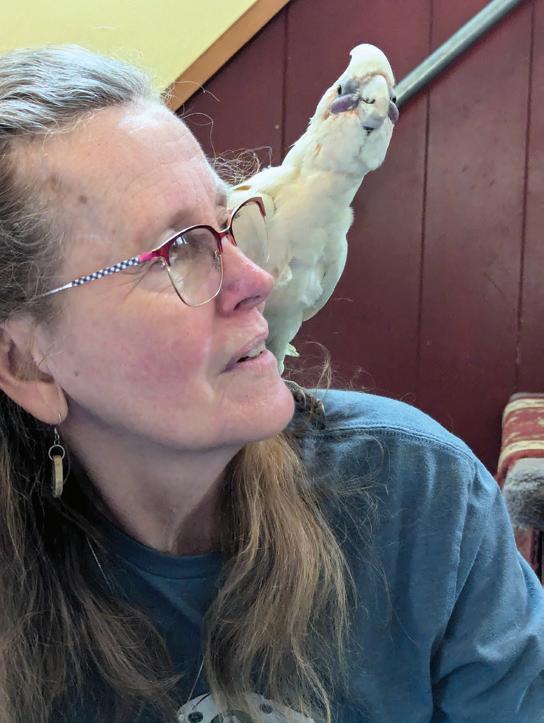
desire to help any creature in need.
After the move here, Denise went to work for Genesis Wildlife Sanctuary in Beech Mountain, and worked there for 17 years until the sanctuary closed in late 2021. Genesis was founded by Leslie Hayhurst, a registered nurse who transitioned from helping people to helping animals. “We took in everything,” Denise said, referring to any injured or sick animal that was brought to them. “Leslie taught me so much!”
One of her favorite responsibilities at the sanctuary was serving as the handler for their ambassador groundhog, Gunther, who was blind. Denise and Gunther regularly traveled to Raleigh, N.C., on Groundhog Day, to appear in a morning television interview at the Raleigh Museum of Natural Science. Like any actor, Gunther had a stage name: Sir Walter Wally. Kind of a southern version of Punxsutawney Phil, but more accurate (Phil was accurate 27% of the time, while Sir Walter Wally was accurate 55% of the time!).
Denise smiled fondly as she recalled how the hotel staff pampered Gunther and let him run around freely, even though pets weren’t allowed on the premises.
In addition to working at Genesis, Denise cared for animals at home as well. She fostered a range of animals and on occasion people would bring her injured wildlife, exotic pets that were no longer wanted, or whose owners were no longer able to keep them. At various times she's rehabilitated raccooons, opossums, various reptiles, deer, wild birds, bats, owls, more groundhogs, a red fox, and even a coati mundi, a mammal native to Latin and South America that been purchased as a pet then discarded. And she loved each of them. Any wild animal she took in that she was able to heal and could survive on its own in the wild was released. As much as she loves having them around, she understands that wild animals belong in the wild. Although retired now, Denise continues to care for animals. She volunteers with East Tennessee Spay and Neuter, and tends to the animals still residing with her, to include six dogs who live there permanently and one foster, five cats, three goats, multiple chickens of varying breeds, two horses, two tortoises, two box turtles, too many exotic birds to count, one bat, one groundhog, and one black rat snake. According to her husband, Ron, she has the rare "Nokay" disease. When someone asks her to take in an injured or abandoned animal, her response is “N-, n-, n-, n-okay.”
Ron and Denise live on three acres in a remote holler near the top of the Roan and evidence of their love of animals is displayed in the habitats and homes they’ve created for Denise’s charges. To include a large, fenced area for the goats near a spring-fed stream, and what Denise refers to as “Coon-ey Island,” a goodsized island created by a stream braid, where it splits then returns to a single stream. There the couple have constructed large pens for various animals, such as Goofy the Groundhog, to spend time outside during
warmer months. Denise and her granddaughter enjoy camping on Cooney Island when the weather’s warm enough. I'm going to beg for an invite.
Although she no longer takes in animals on a professional basis, it’s safe to say this kind-hearted woman is unlikely to turn away any creature in need of tending.
“People call me the ‘Crazy Critter Lady,’” Denise said with a smile. That may be, but from where I sit, I’d call her an Angel to Animals.


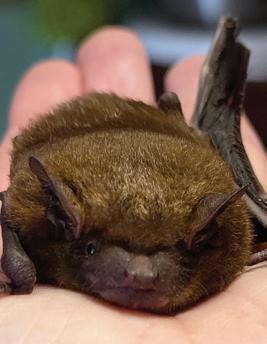
Top: A red-footed tortoise who isn't quite as grumpy as he looks.
Above: A young box turtle whose growth was stunted due to improper diet.
Left: A little brown bat, Echo (who I was allowed to name) whose wing is broken beyond repair, resting in the palm of my hand.



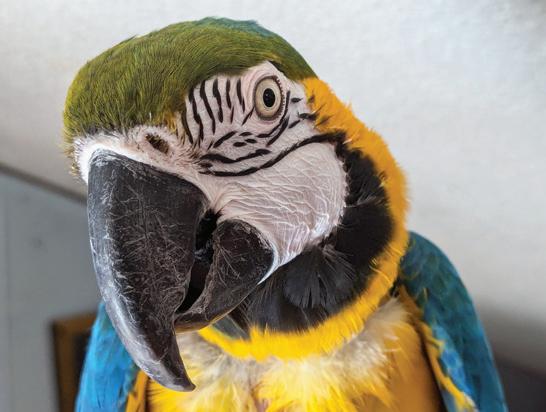
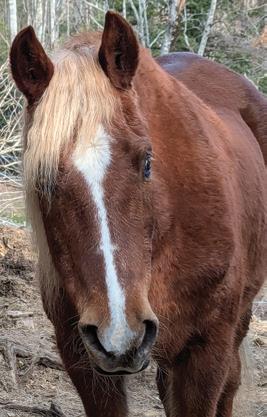
Top: Mike the black rat snake and Sampson the blue and gold macaw. Center left: Goofy the groundhog. Above, Stormy the sweet, but blind horse. Center right, Martha White the goat.
Right: Denise with one of her chickens.
Left: Fern, a sweet pup Denise is fostering, who's in need of a good home. She would do well with an older couple. Very calm and loving. Wouldn't you love to give this sweet girl a good home? Reach out to me.
Thank you, Denise!
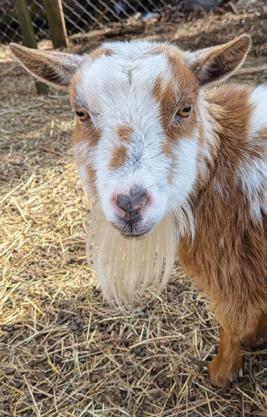

By Ericka Hughes
Some musicians play music because they enjoy it, and others play because they have to—because music is in their blood, in their bones, and in the way they see the world. Noah McKinney is the latter. This 24-yearold singer-songwriter, and acoustic guitar player, carries the heart of country music inside him, blending its storytelling roots with rock, folk, and gospel influences to create a sound that is real and timeless.
Originally from Hudson, Florida, Noah moved to Roan Mountain, Tennessee, with his family, who wanted a slower, small-town way of life. Roan Mountain, with its rolling Appalachian hills, deeprooted musical traditions, and tight-knit community, was the perfect place for them. For Noah, it wasn’t just about moving to a new town—it was about finding a home where music still meant something. In Roan Mountain, music isn’t just entertainment; it’s a way of life. The stories are real, the songs are honest, and the people appreciate music that comes from the heart.
Since his move, Noah has made a name for himself as a dedicated, hardworking musician who isn’t in it for the flash or the fame. He plays because music is his purpose. He classifies himself as a singer-songwriter first and foremost, someone who believes in crafting great songs above all else. He doesn’t just write for the sake of writing—he writes because every song should mean something.
"I believe in well-written songs. That’s what it’s all about. Simple, concise, and something people can understand."
Noah believes music doesn’t need to be overly complicated to be powerful. The best songs say the most with the fewest words. That’s what he strives for—songs that capture real-life experiences in a way that’s raw, honest, and deeply human.

For every musician, there’s a moment when everything shifts—when music stops being just something they enjoy and becomes something they have to do. For Noah, that moment happened on March 20, 2015, at Amalie Arena in downtown Tampa. That night, he attended his first-ever concert: Eric Church.
"I thought I was seeing a typical country music show. This guy opened with a hard, in-your-face rock song, The Outsiders. That changed my life. From then on, I got the idea of trying to get a guitar in my hands. Trying to sing, trying to do it with feeling. Trying to make something of myself."
That night, something clicked for Noah. The energy, the emotion, the storytelling—it all hit him like a freight train. Eric Church wasn’t just playing music; he was living it, breathing it, feeling it. That’s what Noah wanted to do. From that moment forward, he started working toward becoming an artist who could make people feel the way he had felt that night.
Noah’s music is hard to define in just one word. His style blends rock, country rock, folk, classic country, and a touch of gospel. He’s influenced by artists like Hank Williams Sr., Johnny Cash, Tom Petty, and, of course, Eric Church. But he doesn’t try to sound like anyone else.
"I just play good American music—music everyday people listen to."
That’s what makes Noah stand out. He doesn’t chase trends, doesn’t try to fit into one category—he just plays what feels real. His music is meant for working people, dreamers, and those who still believe that a great song can tell a great story.
While Noah is one of the most polite, humble, and easygoing musicians you’ll ever meet, he’s also intensely serious about his craft. He isn’t the type to jump on stage and just wing it—he believes in preparation. Some might mistake his occasional hesitation to play alongside others as shyness, but the reality is, he wants to be fully ready before he performs.
"If I’m stepping on that stage, I want to give 100% every single time."
That belief is what separates Noah from so many other artists. He gives his heart, his soul, and everything he’s got because he believes that’s what music deserves.
Honoring the Legacy of Hank Williams Sr.
Another artist who has deeply influenced Noah is Hank Williams, Sr. Noah admires how Hank could take the simplest lyrics and make them feel like the most profound thing you’d ever heard. That’s the kind of songwriting Noah aspires to—songs that cut straight to the heart without unnecessary complexity.
"Hank knew how to say a lot with just a few words. That’s the kind of music I want to make—music that speaks to people."
Whether he’s singing about love, loss, or life’s tough lessons, Noah’s goal is always the same: to make music that means something.

Where to Catch Noah
Noah has played at several venues that appreciate real, roots-driven music. He made his debut at Jiggy Ray’s Downtown Pizzeria in Elizabethton, a venue known for its welcoming atmosphere and appreciation for live music. He’s also played at Michael Waltrip Brewing in Bristol, a spot that attracts a wide variety of music lovers.
Noah’s next big show is at The Appalachian Station at 19E in Roan Mountain on Saturday, March 29th at 7:30. This venue is special to him because it represents everything he loves about small-town music culture. Fans can expect an honest, heartfelt, and powerful performance—songs that reflect his life, his passion, and his dedication to his craft.

As Noah continues to grow, his devotion to keeping traditional country music alive remains unwavering. He doesn’t care about fame, trends, or industry games—he cares about the music.
He’s part of a rare breed of musicians who still believe in the power of a great song. Whether he’s playing in Roan Mountain or on a bigger stage, one thing is clear: Real country music isn’t dead—it’s alive and well in the hands of Noah McKinney.
Note: On March 29, Noah is the opening act for rock band Virginia Sweet. Be sure to arrive by 7:30 so you don't miss him!
Andrea recently visited with her aunt, Betty Hoilman, who shared stories of growing up on Shell Creek.
By Andrea Mathews
Life in Roan Mountain looked a lot different in Betty Hoilman’s childhood. It was a simpler time, filled with hard and happy memories. She was born in 1948 and grew up on Shell Creek with her five siblings where generations who came before her had also lived. In fact, her mother, Dorothy Guinn’s maiden name was Shell. It was her people who originally settled there.
Betty had to walk a quarter mile to catch the school bus every day. Well … she didn’t have to walk, per se. Her older brothers, whom she had wrapped around her finger, carried her by piggyback. Her older brother, Harold (my paternal grandfather), carried her to the bus stop in the mornings and her younger brother, Rick, carried her back home in the afternoons.
On one occasion, her brother was carrying her on his back as they walked back home after the sun had already set. When climbing over a fence, Betty lost her balance and fell off. It was getting dark and the boys couldn’t see where she’d landed. To make matters worse, the impact of her fall knocked the breath out of her and she couldn’t cry for help. For a few moments, the panicked siblings thought their sister had been lost to the woods. Eventually Betty found her breath and announced her location as she started crying. Her relieved brothers scooped her up and carefully carried her back home.
Betty says Harold must have carried her a million miles across the mountain before she got too big. Reflecting on his battle with cancer before he passed, she says, “Maybe I carried him a few when he got sick.”
She and Rick were particularly close. She says they used to hike out in the woods and find pine trees side by side to climb. Higher and higher they’d ascend until the branches got flimsy and started to bend with their weight. Then, they’d “get the branches to swingin’” to see if they could switch trees while still in the air. The daredevils never got hurt but it’s something Aunt Betty doesn’t recommend any readers try.
There used to be a skating rink in Roan Mountain. Aunt Betty says that’s where the North Carolina boys
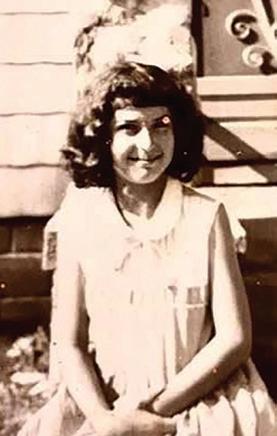


would come to meet up with the Tennessee girls. Betty, however, was not allowed to go because according to her mother, “nice girls don’t go to the skating rink.” Once, some teenagers were going to have a hayride. Betty wanted to go, but her mother told her that “nice girls don’t go on hayrides, either.” In that case however, her older brother, Harold, and his wife, Shirley (my paternal grandparents), were going to be there to supervise, so Betty’s father overruled her mother and she was able to go.
Betty says the Tea Room was “the going place” when she was growing up. She has fond memories of her dad taking them for a frozen custard as a special treat. She also frequented Ed Richardson’s store which was very close to her school. Her Uncle Floyd used to give her pennies to spend at the store. She felt like the richest girl on the playground. Her uncle doted on her and she loved him very much.
When asked if she had any advice for this generation of kids growing up in Roan Mountain, she was quick to say, “Get an education! Take school seriously, get a good job, and don’t give up!” This is advice Aunt Betty has followed herself. She’s incredibly smart, hardworking, quick-witted, and resilient. She is an incredible friend and I think she’s nice, whether she ever went to the skating rink or not.
Story by Diana Tolley
Spring had always been a wonderous time for Robert McCloud. Indeed, it seemed to be everyone’s favorite time of year, but in the Highlands of East Tennessee and Western North Carolina, it was also the most welcomed. The fresh air felt wonderful on the young boy’s face. Robert had tramped through the snow and the cold long enough.
His mama had a thing about education and she’d always insisted, every bloomin’ fall and winter, on sending him and his three sisters to school. Robert didn’t see much sense in all that book learnin’ and test takin’ but the girls seemed to like it good enough.
For a lively 10-year-old boy like himself, there was plenty of things to learn outside of that schoolhouse. Being cooped up with Miz Forbes all day wasn’t his idea of fun. She was a right nice lady and all, but Robert had stuff to do. Such as fishin’ and huntin’, so him and daddy could help store up their food supply. There was always things to repair and the late garden stuff to gather in the fall. Things like learning to be a man was important and his daddy was the one to teach him that. So he didn’t see why school was a have-to thing.
But to his mama, schoolin’ was more important for the young’uns. And what mama said pretty much was the law. So through the sun and heat of autumn, the cold and snow of winter, off to school they went. Down Shell Creek, across the old foot log, then down through the woods to the fancy two room building in the valley.
This winter had been a tough one, as they tended to be in the mountains, but it was nearing the end and he couldn’t be more thankful. On this particular morning, Robert led the way with his younger sisters walking behind him, hand in hand. Whoever was the closest kept her hand in the pocket of her brother’s bibbed overalls and held onto her sisters. That way, if one fell in the creek, they all fell in. That was only right to the boy’s way of thinkin’. After all, what was good for the goose was good for the gander.
Mama kept them home only if the snow was up to their knees. On those days, they all sat around the table as she read to them from the Bible and maybe one of the readers the teacher let them borrow. But they didn’t have to do it all day long ‘cause chores had to be done. Robert was glad of that. Even being outside freezing his tail off was better than listening to Teacher explain math problems. It was a good thing that Spring was just around the corner.
However, freezing your tail off going to school just plumb made no sense. As he motioned for the girls to

hold up on that cold March morning, Robert looked at the big footlog coated in ice. Frozen icicles hung down the sides of it like the wood was weeping. He didn’t blame that old, knobby tree, not one little bit. He felt kinda weepy himself thinking about how very likely him and the girls were gonna get wet. Studying on it a minute, Robert scratched his head underneath the old worn, wool cap that daddy had given him. “Hmmm,” he mused out loud.
“Come on, Robbie! We’re gonna be late if we don’t hurry. The woods is bound to still have some snow and that’ll take time,” Sarah Jane said.
“My feet is gettin’ cold and I don’t want my underbritches to get wet,” Rachel piped up. The youngest, Ruthie, just stood there blowing puffs of mist into the air, trying to catch them with her covered hands.
“Y’all just hold on a minute. I gotta scrape some of this ice off the footlog before we cross it,” Robert told them, without looking back. Slowly he eased down the creek bank and, when he got to the old felled tree, slid one boot across it hard. ‘Yep,’ he thought. ‘Slick as a Tinker’s wink.’
Looking up and down the creek, he couldn’t see any easy way of crossing. All the rocks were frozen over too. The two bigger girls could’ve probably made it a little further down stream but not Ruthie. Her little legs were too short.
Being the big brother, Robert knew it was up to him to get them across and safely to school. He looked down


at his old, hand-me-down leather boots. Daddy had mended the soles more than a time or two, and the toes were still a little too long. But they’d been rubbed down in Bear grease and seasoned by the wood stove overnight, which helped them to not take on water as much. Heaving a big sigh, Robert turned to Sarah Jane and motioned her towards him.
“Robbie, you can’t carry us across. You’ll get all wet and catch your death,” his sister told him.
“Well, Sarah, if you have any better ideas let’s hear ‘em,” he replied. Ruthie puckered up to cry while Rachel just rolled her eyes.
Right about the time Robert decided he had a good enough reason for them to head home, he heard a loud, crunching noise coming from the direction they’d just walked. It sounded like a herd of cattle ambling towards them but nobody around Shell Creek owned that many cows. The noise grew steadily closer. As the children stared up the path, the wind picked that moment to blow a swirl of frost and leftover snow outta the trees, making it hard to see what was coming. All that was visible was something big and brown.
Suddenly, Rachel shrieked, “It’s a BEAR!” Which had Ruthie scrambling over to her brother and climbing him like a monkey. Sarah grabbed hold of his arm as he pried Ruthie off the top of his head and handed her to his sister. Stepping in front of the girls, he spread his arms out and planted his feet wide. If that big ol’ bear charged them, he’d push the girls back and tell them to run. He knew if he could draw its attention and make himself appear larger than life, then it might give them time to cross the creek and run for help. He had a few seconds to regret not carrying his papaw’s old double barrel shotgun. Then remembering how it had knocked him for a loop last time he’d fired it, Robert prayed a quick prayer. “Lord, if that there bear is hungry, let him have a hankerin’ for trout.” Just then, the wind died down and the puffed clouds of animal breath could be seen. Robert started jumping up and down and yelling fiercely. The girls looked at each other then started waving their arms and shouting like crazy. Robert stopped long enough to give them a confounded look, then went back to bouncing and making a loud racket as the animal came into full view. Their noise died down immediately to nothing, and Robert stopped his jumping and arm flapping. The girls grabbed hold of their brother’s arms and stood in stunned silence.
An old mule team plodded along, with a man on the back of one. Old Jack, the oldest mule, honked like a goose when he saw the children. It almost sounded like he was laughing at them. As Daddy pulled up along side, Ruthie shrieked again, but this time she was laughing as she ran toward their father. With a big ole grin on his face, Mr. McCloud scooped up his daughter and hugged her. “What in the tarnation was all that racket about?” He asked the others with laughter in his voice.
“Well, Robbie thought a bear was coming and….” Rachel started.
“Whoa now,” her brother quickly cut her off. “You was the one screaming it was a bear!”
The man chuckled while his three older children argued over what they had actually been doing. After a time, they quieted down.
“What are you doing here, Pap?” Sarah asked.
“Well, I got to thinking that the creek might be hard to cross. It’s still froze in places. So I brought the mules down to see if y’all needed help gettin’ to school.” The children looked at each other then quickly scrambled over to the animals.
“I had it under control, Daddy,” Robbie said as he mounted then pulled Sarah Jane up behind him.
“You sure did!” Piped up Ruthie. “He was gonna carry us over through the creek himself, so Rachel’s under-britches didn’t get wet, but Sarah said he’d die and I didn’t want Robbie to die. Then the bear was coming and we all screamed and then there you was. Thank you, Daddy. I’m glad you’re not a bear.” They all laughed at the little girl’s retelling, cause that was about it in a nutshell.
As they proceeded to cross the icy waters of Shell Creek, Robert lifted his face to the blue sky. Yep, Spring was coming and it was his favorite time of the year. The days were already gettin’ longer. Wouldn’t be long until garden planting time and then school would be out. He closed his eyes as the mule gently swayed while wading through the water. When they were on the other side, the young boy looked over to find his dad smiling at him.
“Good job, son,” he said.
Robert just nodded. Being a man was hard, but if he could be half the man his dad was, he figured he’d be more than alright. With that happy thought, he took the lead and steered old Jack toward school.

(For kids of ALL ages!)


Albert Einstein
Aquamarine
Aries
Ash Wednesday
Daffodil
Daylight Saving Time
Equinox
Fat Tuesday
Flowers
Green
Ides of March
In Like A Lion
Irish

Lent
Leprechaun
Mardi Gras
Mars
Out Like A Lamb
Pi Day
Pisces
Rainbow
Robin
Shamrock
Spring
Windy
Worm Moon



3/16 Crochet Class
3 pm The Appalachian Station at 19E 9367 Hwy 19E (423) 732-0450

Join us as we learn the craft of crochet. Bring your own hooks & yarn. (event listed on Facebook)
3/22 Women's Craft Party
6 pm Morgan Branch FWB 302 Morgan Branch Road
Paint party by Janet. Please find event on Facebook & send message if you'd like to attend.
3/22 Josie J & Dessert Concert
7:30 pm The Appalachian Station at 19E 9367 Hwy 19E (423) 732-0450
Soul/blue/funk/rock/southern soul. No cover charge! (event listed on Facebook)

3/29 Virginia Sweet, opened by Noah McKinney
7:30 pm The Appalachian Station at 19E 9367 Hwy 19E (423) 732-0450
Virginia Sweet: Rock. Noah McKinney: Country. (event listed on Facebook)
4/12 Jazz Funk Adventure
7:30 pm The Appalachian Station at 19E 9367 Hwy 19E (423) 732-0450
Jazz, soul, funk. No cover charge! No cover charge! (event listed on Facebook)
Karaoke with Jesse
Every Friday 7 pm to 11 pm
The Appalachian Station at 19E 9367 Hwy 19E (423) 732-0450
Check Facebook for theme nights.
Saturday Music Circle
Every Saturday 3 pm to 5 pm
The Appalachian Station at 19E 9367 Hwy 19E (423) 732-0450
All are welcome!
Tuesday Night Darts
Every Tuesday, 7 pm
The Appalachian Station at 19E 9367 Hwy 19E (423) 732-0450
3/19 WOW on Wednesday
6:30 pm Lower Shell Creek Christian 8726 Hwy 19E

Youth will travel to TLC in Elizabethton & help with ministry. All youth welcome! Meet in LSCC parking lot.
3/26 Pizza & Bible Trivia
6:30 pm Lower Shell Creek Christian 8726 Hwy 19E
Youth event - join us to eat pizza, learn and have fun! (Event listed on Facebook)
3/28-30 Western Weekend
Times Vary by Day Lower Shell Creek Christian 8726 Hwy 19E
Join Tommy & John Oaks in this fun weekend-long event. Contact the church for more information.

3/30 Night of Worship with music by Chosen
6pm First Baptist Church of Roan Mountain 8498 Hwy 19E (423) 772-9424
An exciting night of praise, worship and music. All are welcome.
4/4-6 Annual Easter Play
Times vary Burbank FWB Church 122 Burbank Road
Join us as for a wonderful time in the Lord as we celebrate the true meaning of Easter.



3/15 Beginner Fly Tying
1 pm Visitor's Center.
Park Ranger Hylen will lead this hands-on 2-hour course and you'll tie your first fly. Must register.
3/28 Raptors of the Roan

3 pm Park headquarters. Meet owl amabassadors and learn about native raptors. Must register.
3/30 Nature Photography: Intro to Basics
9 -11 am Meet at Campground Shelter 3. Lead by Ranger Rodriguez. Bring your camera (or phone).
RM State Park (888) 867-2757
Events listed on Facebook. Must register. To be sponsored by the magazine, email amy@roanmountainmagazine. com.
To have your events included, send to: amy@roanmountainmagazine.com
By Noah Blair
The Appalachian Mountains range from Georgia to Maine and our little town is nestled right among them. It’s one of the oldest mountain ranges in the world and those who inhabit these ancient mountains have long been known for their unique ways of living. This includes things like language, music, food, and traditions.
One of those traditions I was introduced to by my wife’s family many years ago and it has become a staple activity for us in the early spring season. The activity I’m talking about is hunting for wild morels. This hunt doesn’t require a weapon and camouflage, but instead, a mesh bag and a trained eye to find the elusive mushroom known as a morel.
Morchella, or morel mushrooms, are a genus of edible “sac fungi” and are related to “cup fungi.” Morels are extremely distinctive due to their honeycomblike ridges that run vertically on their caps. They’re a delicacy, especially in gourmet restaurants specializing in French cuisine. However, if eaten raw or undercooked they could potentially be toxic.
They are very difficult to cultivate commercially, which makes them a prized commodity. The biggest


reason morels are difficult to produce commercially is the symbiotic relationship they have with certain tree species. This includes trees such as poplar, ash, elm, and especially apple trees. However, even if you stumble across an ash or apple tree on your hike this does not guarantee you’ll find a morel. There are other factors, like what side of the hill you’re on, the soil temperature and moisture levels, are there decaying trees nearby, and more. One wouldn’t think there would be so many issues with finding the elusive morel but it really does take an experienced and trained eye to have any kind of measured success in the hunt for this little ridged mushroom.
I remember getting frustrated when I would miss morels that other, more experienced mushroom hunters would see, or when I thought I was on a honey hole, only to realize one of the many needed factors were missing and I’d wasted my time in an area that would never grow a mushroom. When one does finally crack the code and is able to find Morels consistently there’s a sense of pride you get that feels almost primal, probably tying back to the hunter-gatherer days of early humanity.
All told, morel hunting probably isn’t for everybody and you definitely shouldn’t consume any unless they’ve been prepared by someone experienced. But for those who enjoy difficult but rewarding challenges it might just be for you. There are multiple resources online and many old timers locally who will be willing to give you a few tips but you can bet they will not tell you where their favorite hunting spots are! You will have to earn those.
One more word of advice before I go: If a certain Strickland man on Shell Creek tells you to start looking in June for morels, don’t listen because he will have scooped them all up long before then.
God loves you!





• The magazine is distributed at multiple locations in and around Roan Mountain, as well as nearby communities – we reach both locals and visitors!
• It will always be free to readers.





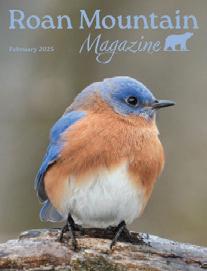

• 2000 are printed and distributed each month (as a start), as well as an accompanying website and social media pages.
• Highly competitive pricing, no set-up or design fees if you provide logo and images. Discounts available for long-term agreements, veterans and first responders.
• Co-op ad design and billing available.
• Discounts available for multi-media ad packages (web and print, when available).
• We’ll promote your company on our social media pages.
• We will actively support our advertisers through focused ad placement, referrals, information sharing, spotlight articles, and more.
• Your support of Roan Mountain Magazine demonstrates your support of our community, allows us to continue to support the community, and allows us to provide the magazine and our website free to our readers.

